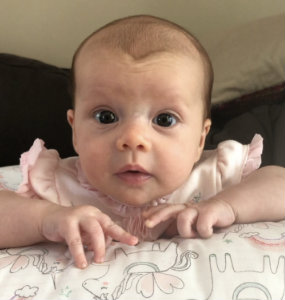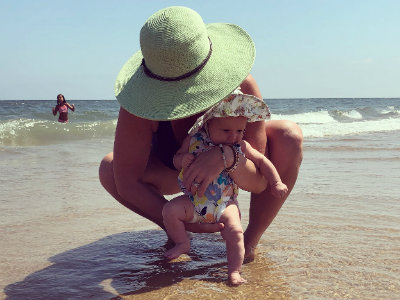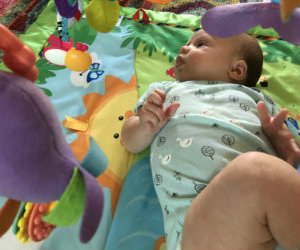
Sadie's Story

The first few moments of Sadie Johnston’s life remain a blur to her mother, Katy.
With her Type 1 diabetes disease management came regular tests during pregnancy. The results were never worrisome. This first-time pregnancy for the 34-year-old and husband Brian, 37, was uncomplicated.Up until the time Katy gave birth.
Though her memories were clouded by anesthesia, her husband and hospital staff let her know that something was wrong with Sadie.
“What I remember is waking up and being told that they were going to helivac her to Children’s National and that I couldn’t go. They weren’t sure if I was going to be able to see her before they took her to the helicopter,” she recalls.

“No. I have to go. I have to go with her,” she remembers sobbing. But that wasn’t an option. Katy was wheeled to the neonatal intensive care unit where she was able to see Sadie through the transport incubator glass.
No one really knew for sure what was happening. Sadie was moving a little bit, but that movement could have been caused by seizures.
“They thought that there was definitely some sort of brain trauma,” Katy says. “There was some swelling in the brain. They weren’t going to know the level of trauma until the brain MRI. First, they put her on the cooler, and it took a couple of days to rewarm her.”
It was five days before Katy and Brian, rejoined at the Children’s National neonatal intensive care unit (NICU), were able to hold their infant.
Sadie had been receiving supplemental oxygen through a nasal cannula. When NICU staff removed it to perform the MRI, the baby’s oxygen levels dropped too low. Because the MRI was delayed, the couple got their first chance to hold Sadie.
“For the first time, her eyes were wide open and she was moving all around,” Katy says.
Over the previous days, Sadie remained very still. She often opened her eyes, but she didn’t look around. Wrapped inside her parents’ arms, she began to squirm. And she kept squirming all the way to the MRI.They had a 1 p.m. meeting scheduled to learn what the brain imaging revealed.

But Taeun Chang, M.D., sought out the family during morning rounds. “ ‘I just want to tell you, her scans look great. I don’t see any trauma on the brain scan,” Katy recalls of their conversation. “It was the best day. It was the highest high. They thought for sure there was some trauma. They weren’t sure what level. We were not expecting these results at all.”
Since Children’s National began offering whole-body therapeutic hypothermia in its neonatal intensive care unit in May 2006, hundreds of infants with acute encephalopathy have participated in the cooling therapy in the first few hours of life to preserve brain cells and to stave off disability or death.
“Therapeutic cooling actually saved many of Sadie’s brain cells and put her back on track for the life she is meant to have. I could see her brain coming back to normal function on her bedside EEG,” explains Dr. Chang, director of the Neonatal Neurology Program at Children’s National in Washington, D.C.
Katy’s tears flow again: “I constantly think about what could have been. But now, she’s just a happy, healthy baby.”

Now aged 3 months old, Sadie rolls over from her back onto her belly. She is starting to chatter and keeps on gabbing. She grabs onto things, including a bright yellow, mirrored toy bumblebee that dangles above her play mat. She greets people she knows with a broad smile, rewarding her parents with her biggest smiles. Her eyes are big and bright, her gaze knowing.
During doctor visits, the family has been told to expect to see her achieve various future milestones. “She’s doing them already. That makes me happy,” Katy adds. And during the family’s recent Labor Day outing to the beach, Sadie was calmed by the sound of the wind and the pounding waves, dozing peacefully under the shade of a domed tent.
“I just think she’s the best. Every day we tell her how special she is and how she’s a total miracle baby: It’s a combination of the doctors being incredible and the outpouring of love from all of our family and friends - and being able to hold her,” Katy says. “All of those things were such a big part of her healing.”
Dr. Chang passed away in June 2022.


